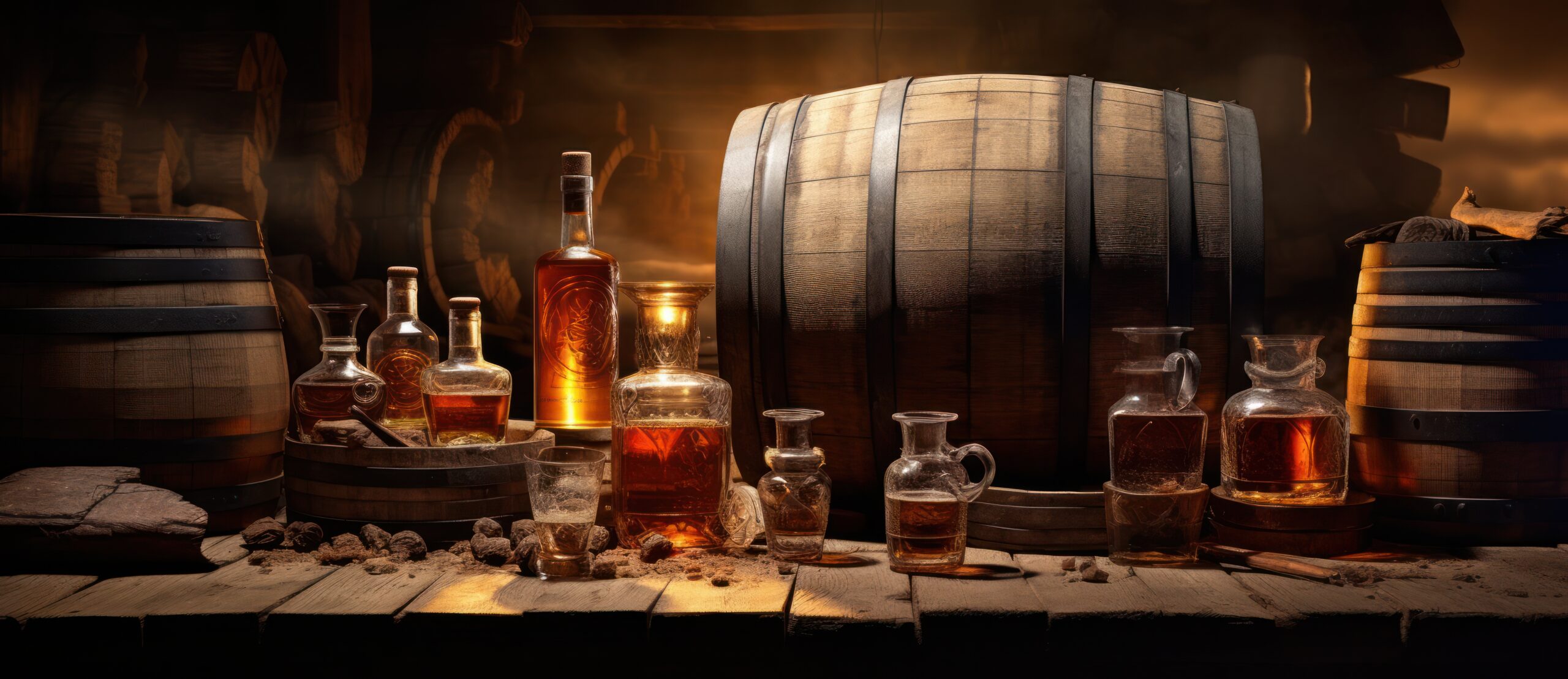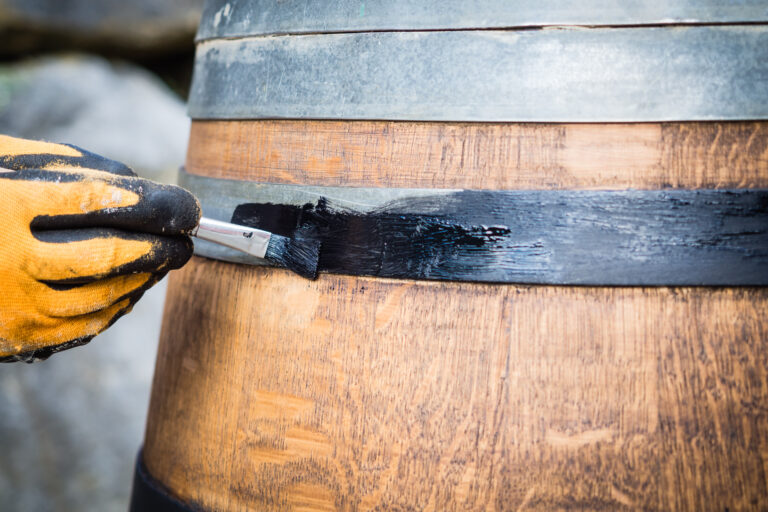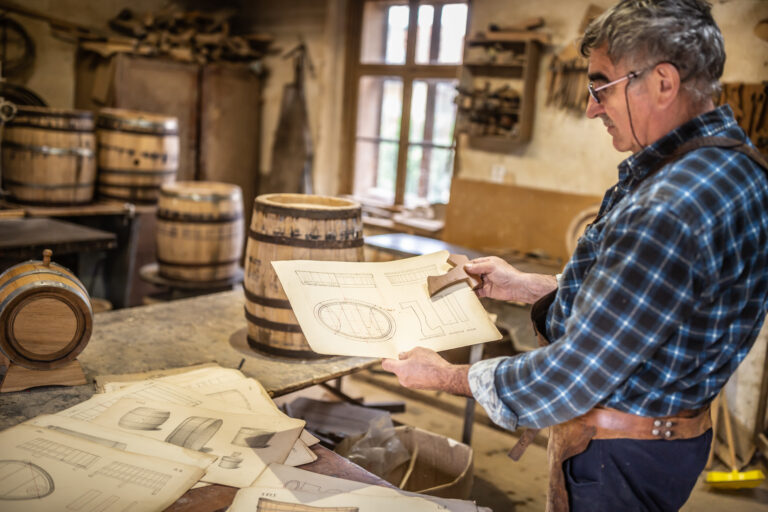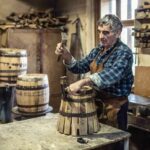Ever wonder why your favorite single malt Scotch has hints of vanilla and oak? The secret lies in how Scotch is made. Distillers age the golden liquid in used bourbon barrels to give it color and flavor. You may be thinking, isn’t bourbon an American whiskey? Why are the Scots using barrels from Kentucky? Turns out, there’s a fascinating history behind this whisky mystery.
The History of Barrel Aging
The history of barrel aging whisky goes back centuries. Distillers originally aged spirits in wooden casks simply because there were few other options. They soon discovered that wood imparted desirable flavors and aromas to the distillate.
In Scotland, distillers found that used sherry casks were ideal for maturing whisky. The sherry soaked into the wood, leaving behind traces that flavored the whisky. Bourbon makers in America had their own discovery. The charred, new oak barrels they used to age bourbon whiskey also worked splendidly for aging Scotch. When prohibition halted bourbon production, Scotland’s distillers gained access to used bourbon barrels. They found that bourbon barrels, with their distinctive char and sweet vanilla notes, were perfect for developing Scotch whisky’s complex character.
Today, many distillers believe that bourbon barrel aging is essential for crafting a superb single malt. The barrels breathe life into the spirit, imparting aromas of vanilla, coconut, and caramel. Two worlds collided, and the result was a whisky match made in heaven. Bourbon’s loss became Scotch’s gain, creating a tradition that lives on to this day.
The Flavors Imparted by Oak Barrels
When Scotch makers age their spirits in used bourbon barrels, the wood imparts tons of flavor to the whisky. The charred insides of the barrels have been soaked in bourbon for years, absorbing the sweet aromas and tastes of the corn-based spirit. All those flavors — vanilla, caramel, coconut — seep into the Scotch during aging, giving it a distinctive smoothness and toasted oak character.
As the Scotch interacts with the wood, natural organic compounds called congeners break down and transform into even more complex flavors. Esters form, resulting in fruity notes of apple or pear. Lactones create buttery sensations. Tannins add subtle bitter touches that balance the sweetness. The longer the Scotch slumbers in its bourbon barrel, the more pronounced these tastes become. A decade or more of aging allows the wood’s imprint to fully permeate the whisky, producing an ultra-rich single malt.
No two barrels age exactly alike, though, which means each bottle of Scotch boasts its own unique flavor profile. The type of oak, barrel size, and conditions during aging all affect how the spirit evolves. It’s this variability and complexity that give fine Scotch its distinctive character. Sipping a glass of aged single malt Scotch that’s been finished in bourbon barrels is like tasting liquid history. All the flavors of the wood and the spirits that preceded it emerge in each flavorful drop. No wonder it’s considered the pinnacle of the distiller’s art.
Why Scotch Uses Former Bourbon Barrels
Scotch makers have been aging their whisky in used bourbon barrels for generations. Why is that? Turns out, there are a few reasons bourbon barrels are ideal for aging Scotch. For one, bourbon barrels impart subtle flavor notes from the charred oak and residual bourbon. The barrels give Scotch woody, vanilla and caramel notes that blend well with the natural malty, fruity flavors of Scotch.
Bourbon barrels are also cost effective. Since bourbon can only be aged once by law, Scotch makers get high-quality barrels at a good price. This helps keep Scotch affordable. Finally, bourbon barrels have the perfect level of char for Scotch. Bourbon requires heavy charring, which opens up the wood and allows the whisky to interact more with the barrel. This level of char provides Scotch with color and flavor without overpowering its natural character. In the end, Scotch and bourbon barrels are a perfect match. The barrels give Scotch extra flavor and aroma in just the right amount, all while keeping costs down. No wonder the tradition of aging Scotch in used bourbon barrels lives on.
The American Bourbon Whiskey Boom
For decades, bourbon whiskey was considered an “old man’s drink” and sales were relatively stagnant. That all changed in the early 2000s with the craft cocktail movement. Mixologists began using bourbon in new, innovative ways in popular cocktails. Suddenly, bourbon was hip and trendy. Distilleries struggled to keep up with the new demand. By law, bourbon must be aged in new charred oak barrels, typically for 2-4 years. With sales surging, distilleries didn’t have enough aged bourbon on hand.
They needed more barrels, and fast. Enter the Scotch whisky industry. Scotch is also aged in oak barrels, but the barrels are usually used multiple times. Scotch makers had a surplus of used barrels they were happy to sell. For Scotch makers, it was a win-win. They made money selling used barrels and gained new customers discovering Scotch for the first time. The influx of used barrels allowed bourbon makers to speed up production and age more bourbon to meet demand. It’s a symbiotic relationship responsible for today’s booming bourbon market. And it’s why many premium bourbons get extra flavor and aroma notes from aging in barrels that once held Scotch. The exchange of barrels between Scotland and Kentucky is a perfect example of innovation, entrepreneurship, and global trade coming together to spur economic growth.
The Effects of Bourbon Barrel Aging on Scotch
The aging of Scotch in used bourbon barrels is what gives the whisky its distinctive flavor and color.
Wooden Wonders
The barrels are typically made of American white oak, which imparts vanilla and coconut notes. As the Scotch matures, it absorbs the flavors of the wood. Compounds in the oak break down into the whisky, giving it a golden amber hue and woody, caramel taste. The previous bourbon also leaves its mark, adding hints of brown sugar, molasses and charred oak. Barrel aging is what transforms the clear distillate into the complex, amber spirit we know as Scotch. Without this maturation period, Scotch would lack depth of flavor and remain colorless.
The Angels’ Share
Some of the Scotch evaporates during aging, known as the “angels’ share.” This loss actually concentrates the flavor and aroma compounds left behind. After several years, the whisky has soaked up the barrel flavors and reached its peak maturity. Once bottled, the aging process stops, preserving the whisky at its prime. The relationship between Scotch and bourbon is a fortuitous one that has stood the test of time. By reusing bourbon barrels, Scotch producers crafted an ingenious method for adding distinctive flavor to their whisky. This intermingling of worlds, old and new, created an indelible spirit that has endured for centuries. What began as a practical measure has become an essential part of what makes Scotch, Scotch.
Not All Scotch Is Aged in Bourbon Barrels
Not all Scotch whisky is aged in used bourbon barrels. While bourbon casks are commonly used, some distilleries prefer to age their whisky in casks that previously held other spirits like sherry or port.
Sherry Casks
Sherry casks were traditionally used to age Scotch whisky before bourbon barrels became popular. Scotch aged in sherry casks tends to be darker in color and have flavors of dried fruit, nuts, and spice. Distilleries like Macallan and Glenfarclas are known for aging some of their whisky in sherry casks.
Wine Casks
Some distilleries experiment with aging Scotch in casks that previously contained wine like port, madeira or red wine. The wine flavors imparted to the whisky can be quite prominent and tend to produce a fruity, sweet taste. A few examples of wine cask-aged Scotch include Glenmorangie Quinta Ruban and Auchentoshan Three Wood.
Other Wood Types
In addition to the standard oak casks, a few distilleries have experimented with different wood types like chestnut, acacia and cherry. These woods can impart more unique and distinctive flavors to the whisky. For example, Glenfiddich ages some of their whisky in ex-pear brandy casks and Balvenie offers a peated whisky aged in ex-Islay whisky casks. While bourbon barrel aging has become very popular, Scotch whisky can have an incredible range of flavors depending on the type of cask used. Distilleries are always innovating to create unique and complex flavors in their whiskies. The variety of casks used in Scotch production leads to an exciting diversity of tastes for whisky lovers to explore.
Other Types of Casks Used for Scotch Maturation
Scotch makers don’t just use bourbon barrels to age their whisky. Other types of casks are also commonly used to impart different flavors and aromas.
Sherry Casks
Sherry casks from Spain are popular for finishing Scotch. The sweet, nutty sherry previously aged in the casks infuses the whisky with raisin, fig and spice notes. Many distilleries use oloroso sherry casks for a richer, sweeter profile. Fino or amontillado sherry casks produce lighter, dry fruit flavors.
Port Casks
Casks that once held port wine from Portugal are sometimes used. The port infuses the Scotch with berry, chocolate and nut aromas. The wine’s high sugar content results in a sweet, fruity finish.
Wine Casks
In addition to sherry and port, casks from other wines like Madeira or Marsala are used. The wine previously aged in the casks imparts subtle flavors to the whisky like dried fruit, toffee or nuts. Wine casks produce a lighter, sweeter taste than bourbon barrels.
Rum Casks
For a tropical twist, some distilleries finish Scotch in rum casks. The rum infuses the whisky with molasses, banana, coconut and spice notes. Rum casks create a uniquely sweet and spicy finish. While bourbon barrels remain the most common for maturing Scotch, other types of casks allow for lots of experimentation. The variety of flavors produced by different wines and spirits aged in the casks provides an array of finishing options for the distiller to craft their perfect dram.
The Scotch Whisky Regulations on Barrels
The Scotch Whisky Regulations strictly govern the type of barrels that can be used to age Scotch whisky. They stipulate that Scotch must be aged in oak casks that have previously held bourbon or sherry.
Bourbon Barrels
The most common barrels used are American oak casks that previously aged bourbon. Bourbon barrels impart subtle vanilla, coconut, and caramel notes to the whisky as it ages. The charred oak barrels also give Scotch its distinctive amber color. Using ex-bourbon barrels is a relatively recent practice for Scotch production, only becoming commonplace in the early 1900s. Before that, sherry casks were primarily used. However, the supply of sherry casks started declining, so distillers turned to the bourbon industry in America for used barrels. Turns out, the bourbon-infused oak barrels were well suited for aging Scotch whisky.
The Scotch Whisky Regulations specify that once a barrel has been used to age Scotch whisky, it cannot be used again for that purpose. So distillers are constantly sourcing used bourbon barrels to keep up with demand. This steady supply of barrels from America helps explain why bourbon casks became the norm for aging Scotch. In the end, the use of bourbon barrels comes down to availability, economics, and of course, the flavor they impart. Without these fortuitous circumstances, Scotch whisky as we know it today might taste quite different. So next time you sip some Scotch, you can thank the bourbon industry for its role in creating that distinctive, oak-infused flavor.
Frequently Asked Questions on Bourbon Barrels and Scotch
Many people wonder why Scotch producers age their whisky in used bourbon barrels. There are a few reasons this time-honored practice came about:
Cost
Used bourbon barrels are inexpensive for Scotch makers to obtain. Bourbon laws require new charred oak barrels for aging, so they can only be used once. Scotch producers get them at a bargain.
Flavor
The bourbon barrels impart a distinctive flavor to the Scotch. Notes of vanilla, caramel and oak are common. The charred interior of the barrels also adds a subtle smoky flavor. Many Scotch drinkers have come to expect these flavors as part of the Scotch experience.
Tradition
Aging Scotch in used bourbon barrels has been done for centuries. Many distillers follow this time-honored method to produce a traditional Scotch flavor profile that consumers expect. Using different barrels might produce a Scotch that deviates too far from tradition.
Demand
There is more demand for Scotch than the supply of used barrels can fill. Distillers have experimented with different barrels but always come back to the tried-and-true bourbon barrel. Consumers tend to prefer the traditional flavor it imparts. While bourbon and scotch are very different drinks, their shared history gives Scotch a distinctive flavor that has stood the test of time. The bourbon barrel’s influence on Scotch is a happy accident of circumstance that has endured for good reason. Both drinks are richer for this relationship.
Final Thoughts
So there you have it, the story behind why Scotch whisky is often aged in used bourbon barrels. A seemingly odd pairing that actually results in a beautiful marriage of flavors. The next time you sip on a glass of aged single malt Scotch, you’ll have a new appreciation for the subtle notes of vanilla and spice that were imparted from its time spent in charred American white oak. A complex spirit made even more complex by its transatlantic journey into the Bluegrass State and back. Though Scotch and bourbon may seem like an unlikely couple, their barrel-aged relationship has stood the test of time. Much like any great romance, what brings them together is far more interesting than what keeps them apart. Sláinte!







